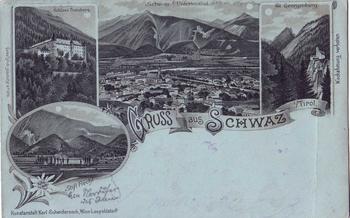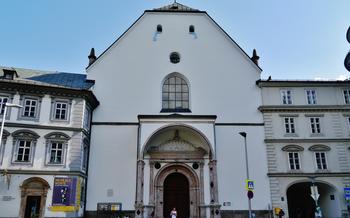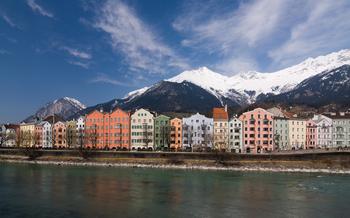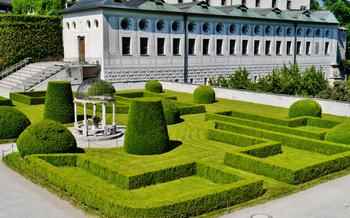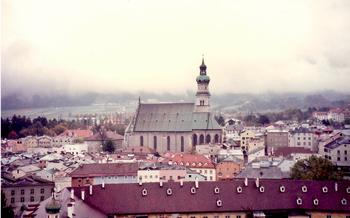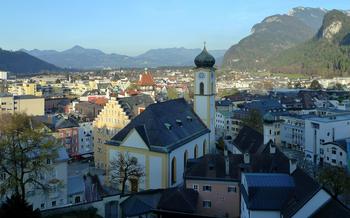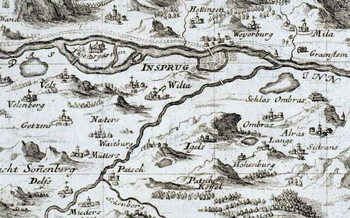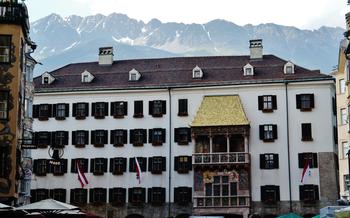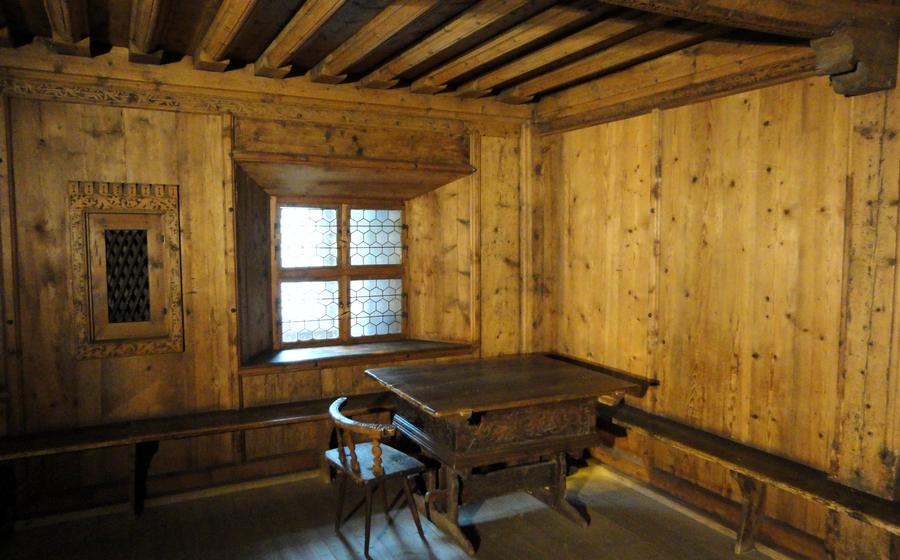
The Tyrolean Folk Art Museum (Tiroler Volkskunstmuseum)
- The Tyrolean Folk Art Museum: A Cultural Treasure Trove
- Exploring the Museum's Highlights
- Unveiling the History of Tyrolean Folk Art
- Tyrolean Craftsmanship at its Finest
- Interactive Exhibits for a Hands-On Experience
- Seasonal Exhibitions: A Window into Tyrolean Traditions
- Guided Tours for In-Depth Insights
- Museum Events and Workshops: Connecting with the Community
- Museum Shop: A Treasure Trove of Folk Art Souvenirs
- Accessibility and Visitor Information:
- Tyrolean Folk Art in the Wider Context
- The Tyrolean Folk Art Museum's Role in Preservation
- Educational Programs for the Next Generation
- Insider Tip: Unveiling Hidden Gems
The Tyrolean Folk Art Museum: A Cultural Treasure Trove
In the heart of Innsbruck, nestled amidst the vibrant streets of Maria-Theresien-Strasse, lies a treasure trove of cultural heritage—the Tyrolean Folk Art Museum. Established in 1888, this remarkable institution is dedicated to preserving and showcasing the rich folk art and cultural traditions of Tyrol, a region renowned for its breathtaking landscapes and vibrant cultural history.
With over 20,000 exhibits spanning centuries of artistic expression, the Tyrolean Folk Art Museum offers visitors a captivating journey into the soul of this enchanting region. From intricately carved wooden sculptures to vibrant paintings depicting scenes of everyday life, from elaborately painted furniture to traditional costumes that tell stories of a bygone era, the museum's collection is a testament to the enduring creativity and artistry of the Tyrolean people.
As you wander through the museum's galleries, you'll discover a world where tradition and innovation intertwine, where the past and present converge to create a vibrant tapestry of cultural expression. The Tyrolean Folk Art Museum is not merely a repository of artifacts; it is a living testament to the enduring spirit of Tyrol, a place where history and heritage are celebrated and where the traditions of the past continue to inspire the creativity of the present.
Exploring the Museum's Highlights
The Tyrolean Folk Art Museum is home to a diverse and captivating collection of Tyrolean folk art, showcasing the region's rich cultural heritage and artistic traditions. Among the highlights of the museum's collection are the intricate nativity scenes, known as "cribs." These handcrafted masterpieces, created by skilled Tyrolean artisans, depict biblical scenes with meticulous detail and vibrant colors.
Another highlight of the museum is the collection of wood carvings. These carvings, often depicting scenes from everyday life or religious motifs, showcase the exceptional craftsmanship of Tyrolean woodworkers. The museum also houses a remarkable collection of painted furniture, a hallmark of Tyrolean folk art. These vibrantly painted pieces, often featuring intricate floral or geometric designs, add a touch of color and cheer to any room.
Finally, the museum's collection of traditional costumes offers a glimpse into the diverse cultural traditions of Tyrol. These costumes, worn for special occasions such as festivals and holidays, are adorned with intricate embroidery, colorful fabrics, and unique accessories, reflecting the region's rich cultural heritage.
Unveiling the History of Tyrolean Folk Art
Tyrolean folk art is a rich and diverse tradition that has been shaped by a multitude of factors over the centuries. Its origins can be traced back to the early settlements of the region, where people relied on traditional crafts to create functional objects and express their cultural identity.
Historical Overview
The history of Tyrolean folk art is closely intertwined with the region's political, economic, and social development. During the Middle Ages, Tyrol was part of the Holy Roman Empire, and its folk art was influenced by the Gothic and Renaissance styles that prevailed in Central Europe. In the 16th century, the region came under the rule of the Habsburg dynasty, which encouraged the development of local crafts and industries.
Cultural Influences
Tyrol's geographical location has also played a significant role in shaping its folk art. Situated at the crossroads of several major trade routes, the region has been influenced by the cultures of neighboring countries, such as Bavaria, Italy, and Switzerland. These influences can be seen in the diverse range of motifs and techniques that characterize Tyrolean folk art.
Socioeconomic Factors
The region's economy and social structure have also had a profound impact on the development of folk art. Traditionally, Tyrol was a predominantly agricultural society, and many folk art objects were created using locally available materials, such as wood, leather, and wool. The region's cottage industry also played a significant role in the production of folk art, with skilled artisans creating pieces that were both functional and decorative.
Tyrolean Craftsmanship at its Finest
The Tyrolean Folk Art Museum is a treasure trove of Tyrolean craftsmanship, showcasing the region's rich tradition of woodworking, painting, and textile arts.
Woodworking: Tyrolean woodworkers are renowned for their intricate carvings, which adorn furniture, sculptures, and other objects. The museum's collection includes a variety of wooden artifacts, from delicate figurines to elaborate furniture pieces.
Painting: Tyrolean folk art painting is characterized by its vibrant colors and intricate designs. The museum's collection features a wide range of painted objects, including furniture, chests, and religious artifacts.
Textile Arts: The Tyrolean region has a long tradition of textile arts, including weaving, embroidery, and lace making. The museum's collection includes a variety of textiles, from traditional costumes to intricately embroidered tablecloths.
Visitors to the museum can gain insights into the techniques and traditions of Tyrolean craftsmanship through interactive exhibits, demonstrations, and workshops. These hands-on experiences allow visitors to appreciate the skill and artistry of Tyrolean craftspeople.
Interactive Exhibits for a Hands-On Experience
The Tyrolean Folk Art Museum offers a range of interactive exhibits that allow visitors to engage with the collection and experience Tyrolean folk art firsthand. Participate in workshops and demonstrations, where you can learn traditional crafts such as wood carving, painting, and textile arts. Skilled artisans guide you through the creative process, providing insights into the techniques and materials used.
Multimedia presentations bring the museum's collection to life, showcasing the stories behind the artifacts and the cultural context in which they were created. Immerse yourself in the sights and sounds of Tyrolean folk art through interactive displays and videos.
Educational activities designed for children and families make learning about folk art fun and engaging. Hands-on activities, such as creating your own miniature nativity scene or designing a traditional costume, allow children to explore their creativity and connect with the museum's collection.
Seasonal Exhibitions: A Window into Tyrolean Traditions
The Tyrolean Folk Art Museum offers a variety of seasonal exhibitions that provide an immersive glimpse into Tyrolean traditions and customs. During the festive season, the museum hosts a special Christmas exhibition, showcasing traditional Tyrolean Christmas decorations, ornaments, and nativity scenes. Visitors can marvel at the intricate details and craftsmanship that go into creating these festive displays. The Easter exhibition, on the other hand, delves into the customs and traditions associated with Easter in Tyrol. From intricate painted eggs to elaborate Easter processions, these exhibitions offer a unique perspective on Tyrolean folk culture.
In addition to these seasonal exhibitions, the museum also organizes rotating exhibitions that explore specific themes related to Tyrolean folk art and culture. These exhibitions might focus on a particular region of Tyrol, a specific type of craft, or the influence of neighboring cultures on Tyrolean folk art. By presenting these temporary exhibitions, the museum offers visitors the opportunity to gain a deeper understanding of the diverse and vibrant traditions of Tyrol.
Guided Tours for In-Depth Insights
To delve deeper into the fascinating world of Tyrolean folk art, consider joining a guided tour led by knowledgeable museum staff. These tours provide an in-depth exploration of the museum's highlights, offering insights and anecdotes that bring the collection to life.
Choose from a variety of thematic tours that focus on specific aspects of the collection or Tyrolean folk art history. Whether you're interested in the intricate wood carvings, the vibrant painted furniture, or the diverse traditional costumes, there's a tour tailored to your interests.
To ensure a spot on your preferred tour, it's advisable to book in advance. Guided tours are available in various languages, so you can choose the one that suits you best.
During the tour, you'll have the opportunity to ask questions and engage in discussions with the knowledgeable guides. They'll share their expertise, providing a deeper understanding and appreciation for the cultural heritage of Tyrol.
Whether you're an art enthusiast, a history buff, or simply curious to learn more about Tyrolean traditions, a guided tour of the Tyrolean Folk Art Museum is an enriching experience that will leave you with a lasting impression.
Museum Events and Workshops: Connecting with the Community
The Tyrolean Folk Art Museum offers a variety of events and workshops that provide an opportunity for visitors to connect with the local community and delve deeper into the world of Tyrolean folk art. These events and workshops are designed to appeal to people of all ages and interests, and they offer a unique way to experience the museum's collection and learn more about Tyrolean culture.
Some of the most popular events include folk art festivals, which showcase traditional music, dance, and crafts. These festivals are a great way to immerse yourself in the vibrant Tyrolean culture and experience the region's rich artistic heritage firsthand. The museum also offers workshops and classes where visitors can learn traditional Tyrolean crafts such as woodworking, painting, and textile arts. These workshops are a great way to connect with local artisans and gain hands-on experience in creating your own folk art pieces.
By participating in these events and workshops, visitors can not only learn more about Tyrolean folk art but also connect with the local community and contribute to the preservation of traditional crafts. These events and workshops are a great way to make your visit to the Tyrolean Folk Art Museum a truly memorable and immersive experience.
Museum Shop: A Treasure Trove of Folk Art Souvenirs
The Tyrolean Folk Art Museum shop is a treasure trove of authentic souvenirs that allow visitors to take a piece of Tyrolean culture home with them. From intricately hand-carved figurines and ornaments to finely crafted textiles and ceramics, the shop offers a diverse selection of unique items that showcase the region's rich craftsmanship.
Visitors can browse through a variety of wooden figurines depicting traditional Tyrolean scenes, each meticulously carved and painted by skilled artisans. These figurines make for charming souvenirs or decorative pieces that add a touch of Tyrolean charm to any home.
Textiles are another highlight of the museum shop, with a wide range of hand-woven and embroidered items available. Visitors can find traditional Tyrolean costumes, aprons, and scarves, all featuring vibrant colors and intricate patterns. These textiles are not only beautiful but also practical, allowing visitors to incorporate Tyrolean style into their everyday lives.
Ceramics are also well-represented in the museum shop, with a variety of hand-painted plates, mugs, and vases available. These ceramics are often adorned with traditional Tyrolean motifs and patterns, making them both decorative and functional.
By purchasing these authentic Tyrolean folk art souvenirs, visitors not only take home a piece of the region's cultural heritage but also support the local artisans who continue to create these beautiful works of art. The museum shop is an essential stop for anyone who wants to immerse themselves in Tyrolean culture and bring a piece of it back home with them.
Accessibility and Visitor Information:
The Tyrolean Folk Art Museum welcomes visitors from all backgrounds and abilities. Wheelchair ramps and elevators ensure that the museum is accessible to visitors with limited mobility. Accessible restrooms are also available throughout the museum.
Visitor information is provided in multiple languages, including English, German, and Italian. The museum staff is friendly and knowledgeable, and they are happy to assist visitors with any questions or inquiries.
Hours of Operation:
- Tuesday to Sunday: 10:00 AM - 5:00 PM
- Closed on Mondays
Admission Fees:
- Adults: €6
- Seniors (65+): €4
- Students: €3
- Children under 12: Free
Available Facilities:
- Museum Shop: The museum shop offers a wide range of authentic Tyrolean folk art souvenirs, including hand-carved figurines, textiles, and ceramics.
- Library: The museum's library houses a vast collection of books, periodicals, and other resources related to Tyrolean folk art and culture.
- Café: The museum's café provides a relaxing space for visitors to enjoy a cup of coffee or tea and a light snack.
- Auditorium: The museum's auditorium hosts lectures, workshops, and other events related to Tyrolean folk art and culture.
Tyrolean Folk Art in the Wider Context
Tyrolean folk art is not only a unique expression of Tyrolean culture but also holds a significant place in the broader context of folk art traditions. The exchange of ideas and techniques between neighboring regions and countries has led to cross-pollination and mutual influences.
Explore the similarities and differences between Tyrolean folk art and the folk art of neighboring regions such as Bavaria, Italy, and Switzerland. Discover how geographical proximity and cultural exchanges have shaped the development of distinct yet interconnected folk art styles.
Delve into the global influence of Tyrolean folk art, particularly on international art movements and cultural trends. Understand how Tyrolean folk art has inspired artists and designers worldwide, contributing to the evolution of contemporary art and design.
By examining Tyrolean folk art in the wider context, you gain a deeper appreciation for its significance and its role in shaping the cultural landscape of the region and beyond.
The Tyrolean Folk Art Museum's Role in Preservation
The Tyrolean Folk Art Museum assumes a pivotal role in safeguarding the legacy of Tyrolean folk art. Its comprehensive collection offers a tangible representation of the region's cultural heritage, providing a valuable resource for researchers, scholars, and the general public alike. In addition to preserving artifacts, the museum actively engages in conservation efforts, meticulously restoring and maintaining its collection to ensure its longevity for future generations.
Furthermore, the museum serves as a hub for documentation and research related to Tyrolean folk art. Its dedicated team of experts conducts extensive research on the history, techniques, and cultural significance of various art forms, contributing to a deeper understanding and appreciation of this unique cultural heritage. Through publications, exhibitions, and educational programs, the museum shares its findings with a wide audience, fostering a greater awareness and appreciation of Tyrolean folk art.
Educational Programs for the Next Generation
The Tyrolean Folk Art Museum recognizes the importance of fostering appreciation for Tyrolean folk art among young learners. It offers a range of educational programs designed for schools, providing interactive and engaging experiences that bring the museum's collection to life. Through hands-on activities, workshops, and guided tours, students can explore the diverse forms of Tyrolean folk art, learn about its history and cultural significance, and develop a deeper understanding of the region's rich heritage.
In addition to school programs, the museum also engages with the wider community through outreach programs and workshops. These initiatives aim to promote folk art education and encourage participation in traditional crafts. The museum collaborates with local artisans, cultural organizations, and community groups to offer workshops on various folk art techniques, such as woodworking, painting, and embroidery. These workshops provide a unique opportunity for participants to learn from experienced craftspeople, try their hand at traditional skills, and connect with the living traditions of Tyrolean folk art.
Insider Tip: Unveiling Hidden Gems
While exploring the Tyrolean Folk Art Museum, be sure to inquire about the museum's hidden exhibitions and lesser-known artifacts that are not on display in the main galleries. The museum staff is often happy to share these hidden treasures with curious visitors. Ask about special collections, temporary exhibitions, or artifacts that are in storage but can be viewed upon request. These hidden gems offer a unique glimpse into the museum's extensive collection and provide a deeper understanding of Tyrolean folk art and culture. Don't miss the opportunity to uncover these hidden treasures and gain a more comprehensive appreciation for the richness and diversity of Tyrolean folk art.
